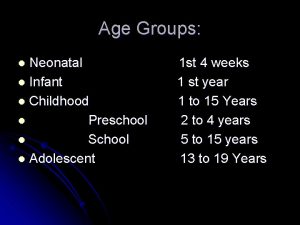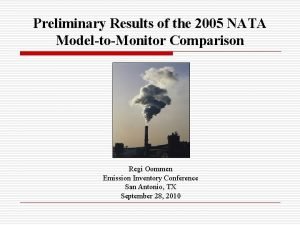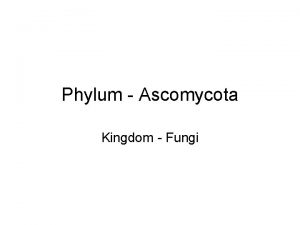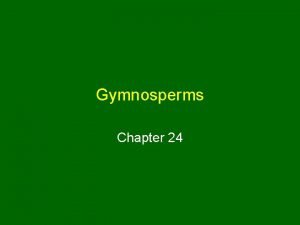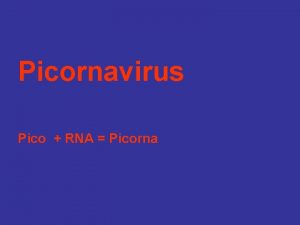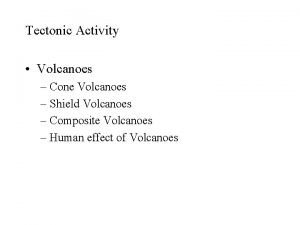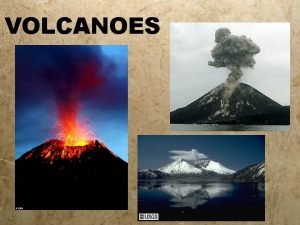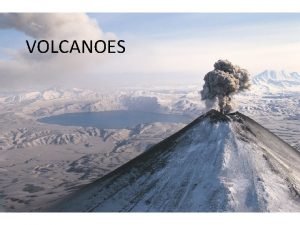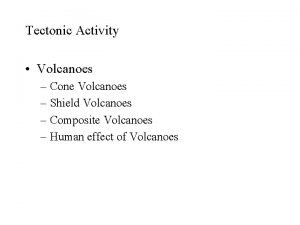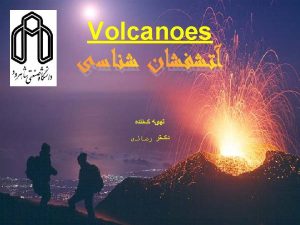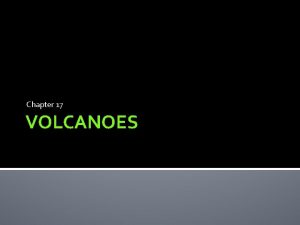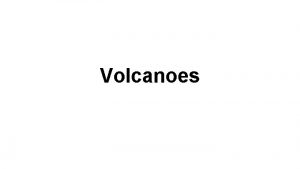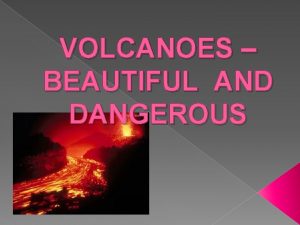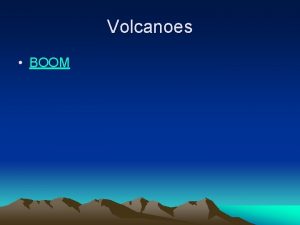Volcanoes Super Volcanoes Naked Science What is a

























- Slides: 25

Volcanoes Super Volcanoes: Naked Science

What is a Volcano? • A volcano is a weak spot in the crust where molten material, magma, from the mantle comes to Earth’s surface. – Magma – a molten mixture of rock-forming substances, gases and water. • When magma reaches the surface of Earth it is called lava. – When lava cools it creates new solid rock.

Location of Volcanoes • Volcanoes can be found at three locations: 1. Divergent Boundaries • Mid-Ocean Ridge Convergent Boundaries Oceanic vs. Oceanic 2. • Oceanic vs. Continental Subduction zones 3. Hot spots • • Stationary openings in the mantle where magma melts through the crust. As the plate moves off the hot spot a new island forms, island chain. Subduction Zone

Inside a Volcano Vent Crater Side Vent Lava Pipe Magma Chamber/ Magma

Inside a Volcano • Magma – molten material that contains dissolved gases and water vapor. – Characteristics of Magma: • Develops in the asthenosphere of the mantle. • Under great pressure and heat • Less dense than solid rock – Due to density and temperature it rises. • Magma Chamber – A large underground pocket where rising magma collects.

Inside A Volcano • Pipe – narrow, vertical crack through which magma rises to the surface of Earth. • Vent – The point on the surface where magma leaves the volcano’s pipe. • Crater – The bowl-shaped area that forms around the volcano’s vent. • Lava – Magma that reaches the surface.

Types of Eruptions • How explosive a volcanic eruption is depends on its silica content. – Silica – a material that is formed from the elements oxygen and silicon. • The more silica magma contains the thicker it is. • Two types of eruptions: – Quiet – Explosive

Quiet Eruptions • Easy flowing magma: (little silica) – Dissolved gases bubble out gently – Thin, runny lava oozes from the vent. – Lava flows many kilometers from the vent. • Two types of lava are produced from quiet eruptions: – Pahoehoe – Aa

Quiet Eruptions • Pahoehoe – Fast moving, hot lava. – Looks like wrinkles, or rope. • Aa – Slow moving, cool lava. – Has a rough surface consisting of jagged lava chunks.

Explosive Eruptions • Thick and sticky magma: (lots of silica) – Builds up in the pipe and plugs it. • Trapped gases build up pressure until they explode. – Lava breaks into fragments that cool quickly and harden. » Volcanic Ash » Cinders – pebble sized » Bombs – baseball to size of a car sized. – Pyroclastic Flow – when an explosive eruption hurls out ash, cinders and bombs as well as gases.

Other Types of Volcanic Activity • Volcanic activity that does not involve the eruption of lava: 1. 2. • Hot springs – when groundwater heated by a nearby body of magma rises to the surface and collects in a natural pool. Geyser – rising hot water and steam become trapped underground in narrow cracks. Pressure builds until the water sprays above the surface. Geyser Hot Springs

Stages of a Volcano • Geologists describe volcanoes in three ways: 1. Active – alive • A volcano that is erupting or is showing signs that it may erupt in the near future. (Hawaii) 2. Dormant – sleeping • A volcano that is in a dormant phase but expected to awaken in the near future and become active. (Mt. Rainier, Washington) 3. Extinct – dead • A volcano that is unlikely to erupt again. (Kauai)

Earth’s Active Volcanoes • Most of Earth’s active volcanoes are located on the edges of the Pacific Plate = Ring of Fire

Volcanic Landforms • Landforms from Lava and ash: – – – Shield volcanoes Composite volcanoes Cinder cone volcanoes Lava plateaus Calderas • Landforms from Magma: – – – Volcanic neck Dike Sill Batholith Dome mountain

Shield Volcanoes • Wide, gently sloping mountains – Thin layers of lava pouring over previous layers • Quiet eruptions

Cinder Cone Volcano • Steep, cone-shaped hill or mountain • Explosive eruption

Composite Volcano • Tall, cone-shaped mountains – Layers of lava alternate with layers of ash • Explosive eruption Mount St. Helens, Washington

Lava Plateau • High, level area – Lava flows out from long cracks • Quiet eruption

Caldera • A huge hole left by a collapsing volcanic mountain after an enormous eruption. – The main vent and magma chamber empty leaving a hollow space. • Explosive eruption

Yellow Stone National Park - Caldera

Yellow Stone National Park - Caldera • Super Volcano • Floor is rising at a record rate or 3 inches/yr since 2004 • 1000 times more powerful than Mount St. Helens eruption in 1980 • Ash would be 10 ft. deep and cover an area over 1000 miles away. • 2/3 rd of the US would be uninhabitable due to toxic air. • Dwarf the effect of Iceland’s Eyjafjallajökull volcano (2010) • The mystery is when it will this erupt?

Volcanic Neck • When magma cools in a pipe and hardens. – Softer rock around the pipe wears ways, exposing the hardened magma.

Volcanic Dike & Sill • Dike – When magma forces itself across rock layers and hardens. • Sill – When magma squeezes between layers of rock.

Batholiths • Large rock masses formed when a body of magma cools inside the Earth’s crust. – When the crust wears away, the hardened magma is exposed.

Dome Mountain • When magma is trapped in horizontal layers of rock. – Black Hills in South Dakota, Mt. Rushmore
 Superworm is super long
Superworm is super long Talk about your favorite subject at school
Talk about your favorite subject at school Presentation nude
Presentation nude Becca bowen naked
Becca bowen naked Lara lewington naked
Lara lewington naked Spallanzani experiment
Spallanzani experiment Naked naber
Naked naber Numberblocks naked
Numberblocks naked Montero aesthetic
Montero aesthetic Childhood age groups
Childhood age groups Kelly elkins nudes
Kelly elkins nudes Patricia joran nude
Patricia joran nude Alex clarke naked
Alex clarke naked اکسپرسیونیسم naked man with rat
اکسپرسیونیسم naked man with rat Appreciate naked
Appreciate naked Science olympiad egg drop
Science olympiad egg drop The greatest contributor to our present gymnastics program
The greatest contributor to our present gymnastics program Naked filipino
Naked filipino Frank fitts
Frank fitts Sudoku naked pair
Sudoku naked pair Nata 2014 results
Nata 2014 results Characteristics of ascomycota
Characteristics of ascomycota What is a naked seed
What is a naked seed Dr brenda lee
Dr brenda lee Adam b nudes
Adam b nudes Pico naked
Pico naked









